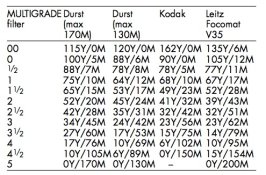splash_fr
Member
Hi all.
Did my first split grade print this weekend and wasted lots of paper. But thats OK, i got a nice result in the end...
Doing the stuff in the darkroom ist obviously different than reading about it in a book.
So a couple of practical questions came up:
(1) With the soft (#00) test strip i want to determine the highlights of the final print. But what if I have a small light area that only covers one or two of the different exposures of the test strip? Should I make several different strips, each with two/three exposures only but all covering the bright part? Or guess the correct exposure even if most of the stripes are only in dark areas?
(2) Should I use #00 or #0 for the soft part? Most guides say #0, but I think most of them mean "the softest you can get". I use a fujimoto g70 dichro with diffuser head by the way.
(3) When the exposure times for soft and hard are identical I could have achieved (more or less) the same with one fixed gradation, right?
(4) If i dodge during soft I increase, during hard I decrease local contrast, right?
So much to do, so little time....
Rgds,
Gerd.
Did my first split grade print this weekend and wasted lots of paper. But thats OK, i got a nice result in the end...
Doing the stuff in the darkroom ist obviously different than reading about it in a book.
So a couple of practical questions came up:
(1) With the soft (#00) test strip i want to determine the highlights of the final print. But what if I have a small light area that only covers one or two of the different exposures of the test strip? Should I make several different strips, each with two/three exposures only but all covering the bright part? Or guess the correct exposure even if most of the stripes are only in dark areas?
(2) Should I use #00 or #0 for the soft part? Most guides say #0, but I think most of them mean "the softest you can get". I use a fujimoto g70 dichro with diffuser head by the way.
(3) When the exposure times for soft and hard are identical I could have achieved (more or less) the same with one fixed gradation, right?
(4) If i dodge during soft I increase, during hard I decrease local contrast, right?
So much to do, so little time....
Rgds,
Gerd.











 )
)